Hello Interactors,
The lengthening northern days have unleashed verdant chaos in my yard and it’s challenging my desire for order. Some unruly growth demands surrendering control, embracing life's rhizomatic entanglements — an invitation to honor multiplicity over singularity, relation over individuality, and emergence over stasis.
Let’s dig in…
FERN FRENZY IN FULL FORCE
Those skinny unattractive immigrants are invading. They’re nudging their way through every nook and cranny stealing resources and opportunity from those already here. Before long, they’ll be taking over the place. I’m talking about Leptinella squalida (Derived from the Greek "leptos" meaning slender and the Latin “squalid” meaning unattractive). That is the scientific name for a New Zealand native ground cover commonly referred to as ‘Brass buttons’ and it’s taking over my garden.
Leptinella squalida is rhizomatous. It sends rootlike horizontal shallow subterranean stems — a rhizome — in a multitude of unpredictable directions. At various intervals in its journey, it progressively produces small nodules that send whisker roots below while sprouting shoots vertically to the surface to form miniature fern-like fronds — sometimes green and other times ‘brass’ colored. Once a year it produces a yellow ‘button’ blossom that can send seeds aloft leapfrogging the host to colonize another territory.
I planted it in a shady moist area of my small backyard after ripping out a grass lawn. Liptinella squalida makes an even carpet that can withstand a fair bit of foot traffic, making it an attractive alternative to grass. Unfortunately, other plants can’t withstand is aggressive propagation, starving them of light and nutrients. That’s exactly what this exponentially expanding rhizome is doing to the slower growing, less aggressively sprawling Sedum rupestre 'Angelina' — a variety I also helped colonize from Western Europe.
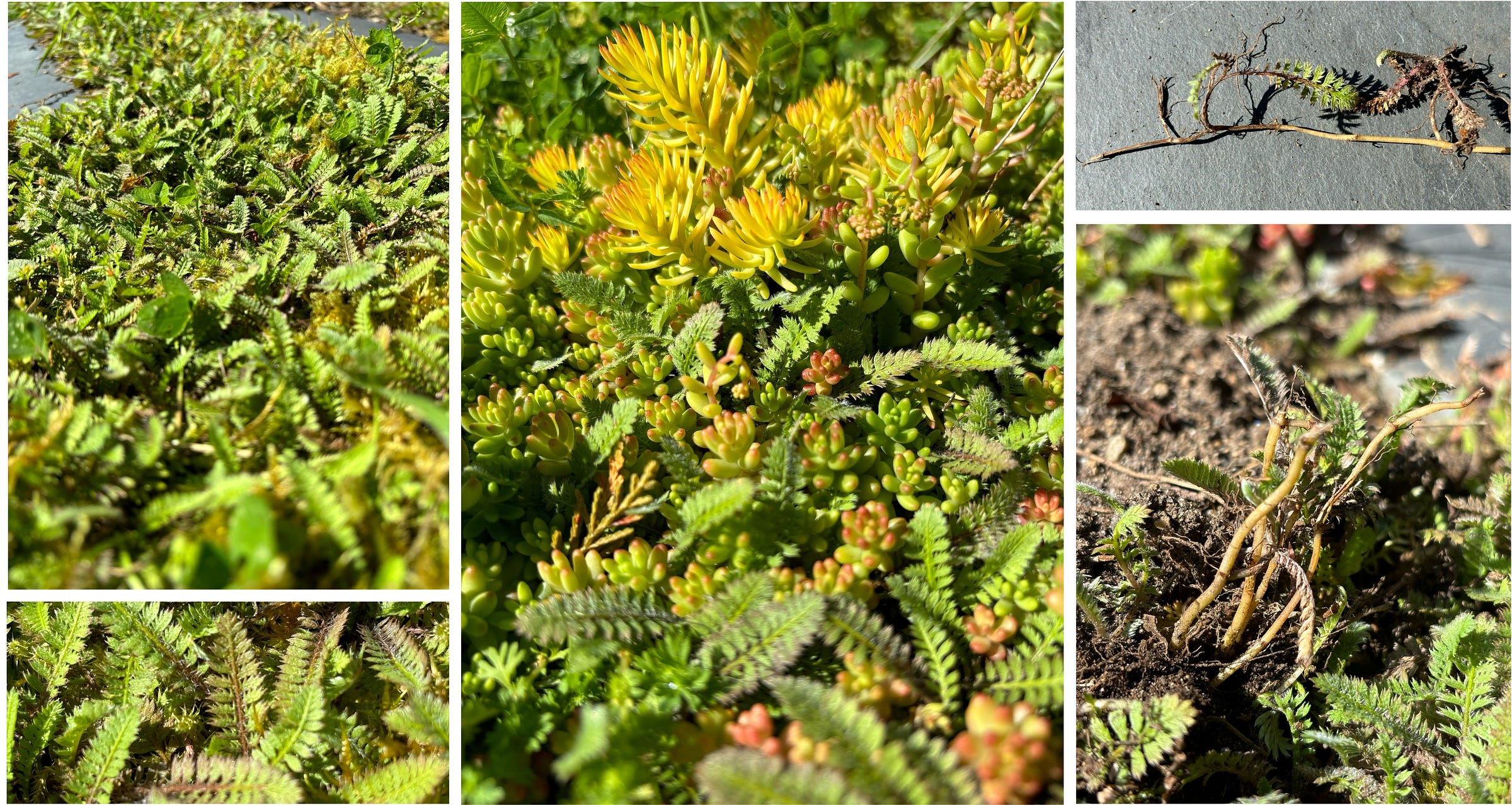
I suspect strict immigration laws should be applied to my little rambunctious rhizomatous island ferns. Last week I eradicated an entire section at the border with a shovel and then carefully extracted the spindly rhizomes from the starved roots and foliage of the ‘Angelina.’ I’m contemplating building a subterranean Trump-like wall to resist the invaders. I may even perform widespread extirpation and dig it all up — especially given the primary section of Brass buttons have also been colonized. They are slowly being overtaken by another aggressive invasive species — clover.
I didn’t plan for this, but I did create the conditions for it to occur. In place of a grass lawn — which offers nothing to ecology in any shape or form — I planted a variety of low growing ground covers, sedums, and clumping ornamental grasses. Many of these ground covers have now intermingled. Some are more dominant in areas than others forming a diverse kaleidoscope of height, color, and texture.
There’s little strict cartesian geometric control I can apply to this tufted tapestry without hard physical barriers. And even then, their airborne spores can gleefully fly where the wind may carry them — oblivious to any tyrannical terrestrial territorial triangulations I may map in my head.
Rhizomes are their own kind of experimental map. They randomly route with their roots. Their genes map the way as MicroRNAs modulate their sway. Meanwhile, subterranean phytohormones signal route initiation and elongation in a coordinated but random multi-directional, non-linear physical cartographic network.
Rhizomic networks have no real beginning or end. They make connections in a non-hierarchical, decentralized way without a single origin or terminus. It is in a continual emergent state of being in the middle of having been made and becoming something new. There is no dualistic hierarchical parent/child branching that dominates Western mental images of hierarchical networks — like a family tree or even a real tree where a trunk sprouts limbs with branches that terminate with leaves. Rhizomatous networks defy rational Cartesian logic.
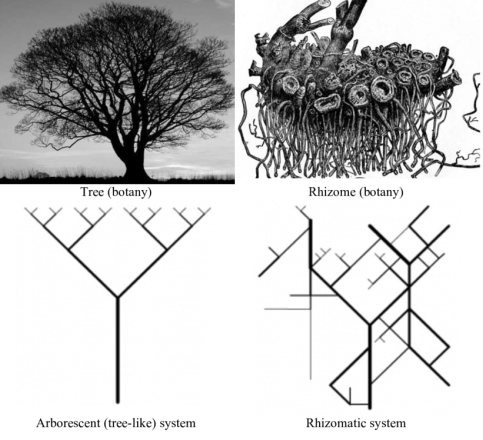
I’ve been reflecting on the tension I’m experiencing as I wrestle and reason with my garden. On the one hand, I’m drawn to the top-down control of crafting a particular order and aesthetic as an amateur landscape architect. The same desire explains my affinity for urban and transportation planning and design…and I suppose my three decades of user interface design. I like attempts at bringing clarity to complexity.
Modern urban planning tries to achieve the same thing. Urban planning has historically relied on hierarchical models characterized by centralized control and top-down implementation. These traditional approaches often use structural or generative frameworks to shape and represent urban spaces. Emphasizing coherence and order, urban planning typically adheres to mapped zoning regulations and legally controlled growth patterns. The focus is usually on achieving defined end-states or visions, imposing order through marginated space with bordered zones and predetermined paths dictated by urban transportation planning policies.
The same can be said for the planning of countries and states. Colonial powers imposed structured urban plans to assert control and organize territories. Their maps, laws, police, and military impose order through variegated spaces at larger scales characterized by bordered zones and throughways. This reflects a continuity in the desire to manage and control urban growth and development of entire regions and even continents.
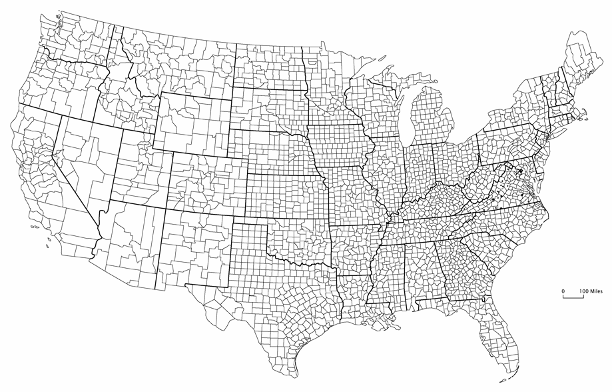
FRICTION FORMS FLUID FRAMEWORKS
The rhizome rejects arborescent structures, favoring non-linear, decentralized networks and connections, incompatible with traditional models. The French philosophers Gilles Deleuze and Félix Guattari's influential "A Thousand Plateaus" introduced the "rhizome" philosophical concept - a non-hierarchical, decentralized network characterized by multiplicity, heterogeneity, and non-linearity. Challenging Western metaphysics, it proposed rethinking reality as a dynamic, interconnected assemblage, embracing a rhizomorphic approach of continuous transformation and new connections over linear thinking.

Insisting on mapping reality through open-ended experimentation rather than tracing existing structures, the concept embraces spontaneous ruptures forming new connections within emergent cultural networks resembling rhizomes. Having no beginning or end, existing in a constant state of becoming, it resists linear urban narratives and stagnant pure identities. Encouraging "lines of flight," the rhizome breaks from constraints of traditional thinking. The urban as a "smooth space" occupied by the rhizome contrasts sharply with hierarchies of Cartesian power and order.1
Human cultures also show evidence of embracing this mode of thinking. They too form new connections regardless of imaginary borders. Jean-Loup Amselle is a French anthropologist known for his studies on African societies, cultural hybridization, and postcolonialism. He introduced the concept of "branchement" (branching) to describe the fluid and interconnected nature of cultures that remind me of what I’m witnessing in my back yard.2
Amselle's analysis of the N'ko movement in West Africa, which aimed to "debranch" the Manding culture from Arabic and European influences, offers parallels to the Palestinian context and others like Sudan and Ukraine.
The Palestinian struggle for self-determination and cultural preservation resists perceived Israeli/Western dominance by asserting Palestinian identity and drawing on global solidarity networks. It shows how local struggles are part of broader global narratives surrounding identities and cultures.
This conflict fuels identity-based movements reflecting Amselle's "identity wars" brought on by globalization and strict mapped borders. Amselle's framework rejects fixed identities, emphasizing the interconnections shaping Palestinian, Israeli, Jewish, and Arab identities. The concept of "branchement" highlights the complex entanglements of histories and global forces in the Palestinian conflict, challenging simplistic narratives of cultural purity and separation.
The same desire for purity and separation is what led me to ponder border control in my own backyard. I’m even contemplating extermination. All because I saw friction at a border where one plant was not ‘plugging in’ to the existing root network, but ‘debranching’ another plants by taking over their lives and land.
Anna Lowenhaupt Tsing is an anthropologist and professor at the University of California, Santa Cruz. She’s known for her interdisciplinary work on globalization, ecology, and the Anthropocene, and for her acclaimed 2005 book "Friction: An Ethnography of Global Connection,"
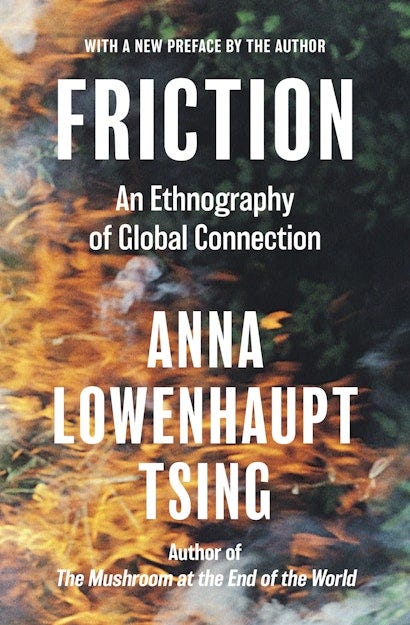
She writes,
"Cultures are continually co-produced in the interaction I call 'friction': the awkward, unequal, unstable, and creative qualities of interconnection across difference."3
Tsing argues that global connections and universalizing projects like dominant forms of Western capitalism, science, and politics do not spread seamlessly but encounter friction and resistance when they engage with specific localities and cultures. These interactions produce new articulations and connections that challenge the universalizing claims of global forces. This, like Amselle, emphasizes the entanglement and co-production of cultures through these encounters.
These "zones of awkward engagement" or "cultural friction" are sites where universals collide with particular situations, producing unexpected outcomes and articulations. That’s what I witnessed between my “brass buttons” and “Angelina”.
“Zones of awkward engagement” and “cultural friction” exist at a city level too as immigrant populations integrate (“plug in” or branch) into established neighborhoods. This can create “cultural friction” as neighborhoods become “zones of awkward engagement”. Zoning and racial or socio-economic redlining are attempts at legal, cartographic, and cultural purity and separation that create awkward zones of friction.
But Tsing highlights the importance of collaborations and coalitions that emerge from these zones of awkward engagement. She says,
"Despite imperial standards for civil society, I have wandered into coalitions built on awkwardly linked incompatibilities."
These collaborations create new interests and ways of being, challenging the singularity of global forces and enabling practices of collaborative knowing and working.
PLANETARY PATHS, RHIZOME ROUTES
I’m starting to see that local urban frictions, be they down the street or in the streets of Cairo, Chicago, Caraco, or Cape Town, are complex entanglements of histories and global forces. They branch like rhizomes in local frictions of awkward engagement, but also branch to entire other parts of the world. My backyard is a reflection of this. I created a ‘branchement’ by planting plants native to vastly separated parts of the globe — New Zealand and Western Europe.
Neil Brenner is a critical urban theorist at the University of Chicago and Christian Schmid is a sociologist and urban researcher at ETH Zurich. They’re known for the influential concept of "planetary urbanization." They claim urbanization processes today are no longer confined to the traditional boundaries of cities, but rather extend across the entire planetary surface.4
They argue the classic "city-centric" view is inadequate to capture the multiscalar and multiterritorial dynamics of contemporary urbanization.
Instead, they propose that urbanization today is a planetary phenomenon that cuts across the urban/rural divide and transcends the boundaries of individual cities or metropolitan regions. Urbanization unfolds through the constant production, transformation, and operation of socio-spatial configurations at multiple geographic scales, from the body to the globe.
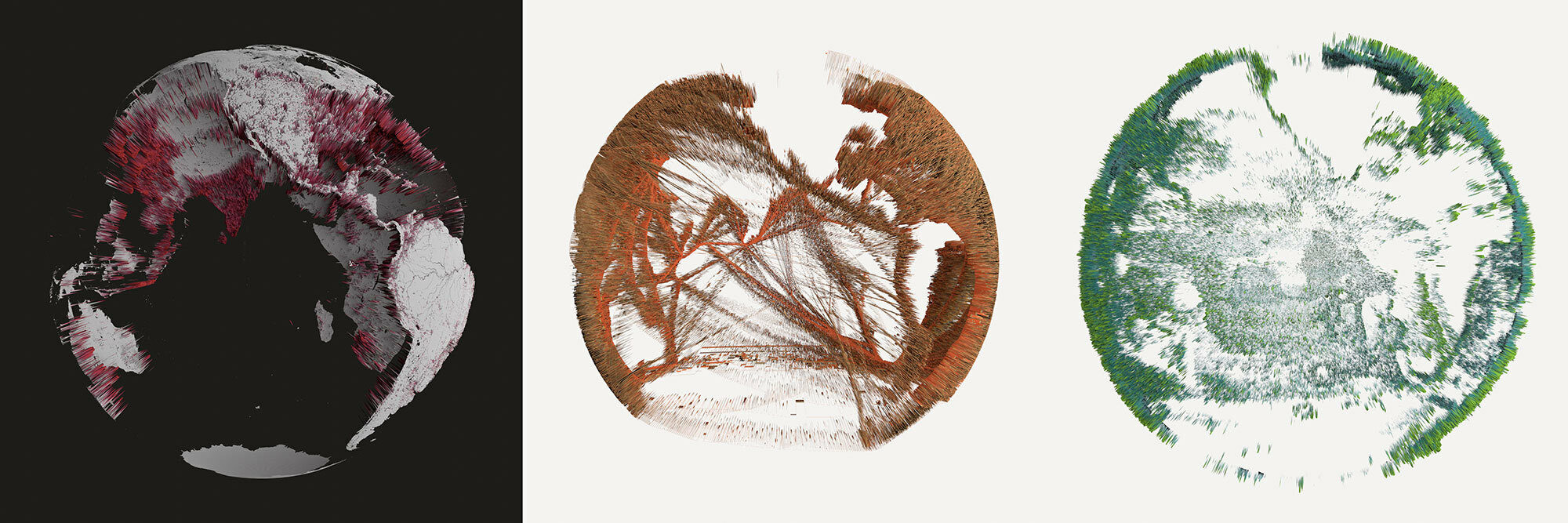
This includes the urbanization of seemingly "non-urban" zones like oceans, deserts, and wilderness areas being operationalized and transformed through various urbanization processes. While cities remain vital arenas for urbanization processes, they are embedded within and co-constituted by broader planetary urbanization dynamics that extend far beyond their boundaries. They argue urban theory must move beyond the city as its primary unit of analysis and develop new frameworks, methodologies, and cartographies to grasp the multiscalar and multiterritorial nature of planetary urbanization.
This starts by recognizing the rhizomatic interconnections and interdependencies shaping urbanization at various scales, from local to global, and the diverse socio-spatial configurations and infrastructures that form the "urbanization fabric" across the planet. They argue that the "urban" is no longer a bounded condition but a generalized, planetary condition of socio-spatial transformation.
The rhizomatic approach emphasizes non-linear and decentralized networks. It offers a valuable framework for urban planning, ecological management, and cultural integration. And even my garden. Just as Leptinella squalida defies linear control in my garden, urban spaces and cultural landscapes resist traditional hierarchical planning. This perspective promotes adaptability and inclusivity, fostering environments that evolve organically and embrace multiplicity and spontaneous connections. They reject unfair dominance or ‘debranching’ or mechanisms by which dominant cultures or systems attempt to appropriate, assimilate, or subjugate other cultures or elements within their sphere of influence.
Deleuze and Guattari's rhizome and plateau concepts critique cultural dominance and embrace multiplicity, diversity, and coexistence without imposing dominant structures. Applying these ideas to urban integration highlights the potential for hybrid solutions and collaborative networks that recognize fluid identities and dynamic cultural interactions. Amselle's "branchement" and Tsing's "cultural friction" emphasize productive tensions from encounters, challenging narratives of purity.
Randomly routing rhizomatous roots, their genes mapping the way, are like the informal settlements and migrant networks. Their sways are modulated by global flows of capital with labor signaling route initiation and elongation in random multi-directional, non-linear physical and virtual networks that reject cartographic convention. Ultimately, this rhizomatic approach aligns with Neil Brenner and Christian Schmid's concept of planetary urbanization by acknowledging the interconnected and multiscalar nature of urban and cultural processes. It calls for new frameworks to understand and address the complex socio-spatial transformations shaping our world. How do we move beyond hierarchical, top-down models that use structural frameworks to shape urban spaces through regulated mapped zones, centralized control, and predetermined paths?
Instead of aiming to impose order and coherence by striving to achieve defined end-state visions of bordered, marginated spaces, how might we embrace the interconnected rhizomatous roots and vines of the global urban interlacement — without one crowding out another? Maybe it’s time we accept the woven flows of cultures, resources, and infrastructures of the past — and the ever-emerging present middle of rhizomatous networks — made from interplace, the interactions of people and place.
Rhizome (philosophy). (2023, May 18). In Wikipedia. https://en.wikipedia.org/wiki/Rhizome_%28philosophy%29
Branchements: Anthropologie de l'universalité des cultures" ("Branchings: Anthropology of the Universality of Cultures"). J. L. Amselle. Flammarion. 2001.
Friction: An Ethnography of Global Connection. Anna Lowenhaupt Tsing. Princeton University Press, 2005.
Planetary urbanization: An urban theory for our time? Brenner, N., & Schmid, C. (2022). Verso Books.
De/re-densification: A relational geography of urban density. Colin McFarlane. 2020.
Deleuze and Geophilosophy: A Guide and Glossary. Mark Bonta and John Protevi. 2004.







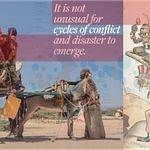




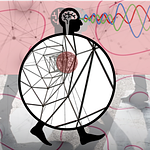

Garden Invaders and Global Rhizomes